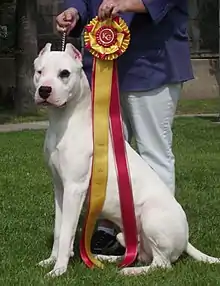| Dogo Argentino | |||||||||||||||||||||||||||||
|---|---|---|---|---|---|---|---|---|---|---|---|---|---|---|---|---|---|---|---|---|---|---|---|---|---|---|---|---|---|
_(cropped).jpg.webp) | |||||||||||||||||||||||||||||
| Origin | Argentina | ||||||||||||||||||||||||||||
| Foundation stock | |||||||||||||||||||||||||||||
| |||||||||||||||||||||||||||||
| |||||||||||||||||||||||||||||
| Dog (domestic dog) | |||||||||||||||||||||||||||||
The Dogo Argentino (plural Dogos Argentinos) is an Argentine breed of large dog of mastiff type. It was bred in the early twentieth century in Córdoba in central Argentina, primarily for hunting large game such as peccaries, wild boar and pumas.[3]: 146 [4]: 340 [5]: 189 [6]: 140 [7][1] The foundation stock included the now extinct Córdoba fighting dog, a fighting dog of bulldog type, a Bull Terrier and a Mastín del Pirineo.[8]: 338 [7]: 21
History
In the 1920s Antonio Nores Martinez, a young student of Córdoba in central Argentina, set out with his brother Augustin Nores Martinez to create a new breed of big game hunting dog, especially wild boar.[1][4]: 340 [8]: 338 [3]: 145-146 He wanted it to have the fighting qualities of the Old Cordoba Fighting Dog, but with greater size and strength.[7]: 23 He started with a Bull Terrier bitch with considerable fighting ability, which he bred to a spotted fighting dog of bulldog type. He selected and inter-bred their offspring, selecting for white coat colour and rejecting any animal that was retrognathous (undershot). In the eighth generation he introduced a Pyrenean mastiff bitch; by the twelfth generation his dogs were breeding true. They became well known for their success in the ring.[7]: 21 Nores Martinez later introduced crosses with a variety of other dogs including the Irish Wolfhound, Boxer, Great Dane, Bull Terrier, Dogue de Bordeaux and Spanish Mastiff.[3]: 146 [8]: 338-339
In 1947 he presented his breed to the Club de Cazadores ('hunter's club') of Buenos Aires; in 1948 a breed standard was published in the magazine Diana.[7]: 28 Antonio Nores Martinez was murdered in 1956; however Augustin, now an international ambassador, would continue to promote the Dogo during his travels.[8]: 339
The Dogo was definitively accepted by the Fédération Cynologique Internationale in 1973.[9]
Characteristics

The Dogo Argentino is a large dog: weights for dogs are some 40–45 kg (90–100 lb), for bitches slightly less; heights at the withers are in the range 60–65 cm (24–26 in) for bitches and 60–68 cm (24–27 in) for dogs.[1][10] The length of the body is slightly greater than the height at the withers, up to a maximum of one tenth more.[1][10]
The coat is short and always white. A single black or dark-coloured spot on the head is tolerated as long as it is no larger than one tenth of the size of the head.[1][10] The muzzle is of about the same length as the skull.[1][10]
Like many other breeds, the Dogo has some genetic predisposition to congenital deafness; it is also predisposed to laryngeal paralysis/polyneuropathy complex.[11]: 3 The dogs usually live for some 10 to 12 years.[2]: 84
Use
The Dogo is kept principally for hunting large game such as peccaries, wild boar and pumas.[3]: 146 [4]: 340 [5]: 189 [6]: 140 [7][1] It has a good nose, and good speed and stamina; it may occasionally be trained for police or military work.[12]: 153
Regulation
Ownership of dogs of this breed is illegal or restricted in some countries, including Australia,[13] the Cayman Islands,[14] Hong Kong,[15] New Zealand,[16] Norway,[17] Turkey[18] and the United Kingdom.[19]
References
- 1 2 3 4 5 6 7 8 9 10 11 FCI-Standard N° 292: Dogo Argentino. Fédération Cynologique Internationale. Accessed December 2022.
- 1 2 Kim Dennis-Bryan (2020 [2012]). The Complete Dog Breed Book, second edition. London: Dorling Kindersley. ISBN 9780241412732.
- 1 2 3 4 David Alderton (2000). Hounds of the World: An Illustrated Guide. Shrewsbury: Swan Hill Press. ISBN 9781853109126.
- 1 2 3 Bonnie Wilcox, Chris Walkowicz (1993). Atlas of Dog Breeds of the World, fourth edition. Neptune City, New Jersey: TFH Publications. ISBN 0866228551
- 1 2 Pierre Rousselet-Blanc (editor) (1992). El Perro (in Spanish). Barcelona, Spain: Ediciones Martinez Roca, S.A. ISBN 8427016824.
- 1 2 Esther J. J. Verhoef-Verhallen, Marion Drolsbach, Rosemary Mitchell-Schuitvoerder (2001). The Complete Encyclopedia of Dogs. Lisse: Rebo International. ISBN 9036615097.
- 1 2 3 4 5 6 Paolo Vianini (2018). El Dogo Argentino (in Spanish). Barcelona: Editorial De Vecchi S.A. ISBN 9781644615850.
- 1 2 3 4 Morris, Desmond (2001). Dogs: A Dictionary of Dog Breeds. North Pomfret, VT: Trafalgar Square Publishing. ISBN 1570762198
- ↑ FCI breeds nomenclature: Dogo Argentino. Fédération Cynologique Internationale. Accessed December 2022.
- 1 2 3 4 Raza: (292) Dogo Argentino. Buenos Aires: Federación Cinológica Argentina. Archived 10 July 2019.
- ↑ Ronaldo C. Da Costa, Curtis W. Dewey (2015). Practical Guide to Canine and Feline Neurology, third edition, ebook. Ames, Iowa: John Wiley & Sons. ISBN 9781119062042.
- ↑ Dan Rice (2001). Big Dog Breeds. Hauppauge, New York: Barron's Educational Series. ISBN 9780764116490.
- ↑ Australian Department of Agriculture (9 January 2023). "What dog breeds cannot be imported into Australia?". Australian Department of Agriculture.
- ↑ "Animals (Prohibited Dogs) Regulations (2012 Revision)" (PDF). Cayman Islands Gazette. Vol. 21 (sup. 3). 8 October 2012. Archived (PDF) from the original on 25 March 2022.
- ↑ "Hong Kong e-Legislation". www.elegislation.gov.hk. Retrieved 10 October 2022.
- ↑ Te Tari Taiwhenua Department of Internal Affairs. "Key Facts: Dog Control Amendment Act 2003". Te Tari Taiwhenua. Retrieved 14 April 2023.
- ↑ "Regulations on dogs" (in Norwegian). Lovdata. Retrieved 29 April 2022.
- ↑ "Tehlike Arz Eden Hayvanlara İlişkin Genelge" [Directive on Dangerous Animals] (in Turkish). Ministry of Agriculture and Forestry. 9 December 2021. Archived from the original on 9 December 2021. Retrieved 7 January 2022.
- ↑ "Banned dogs". GOV.UK. Retrieved 30 March 2022.